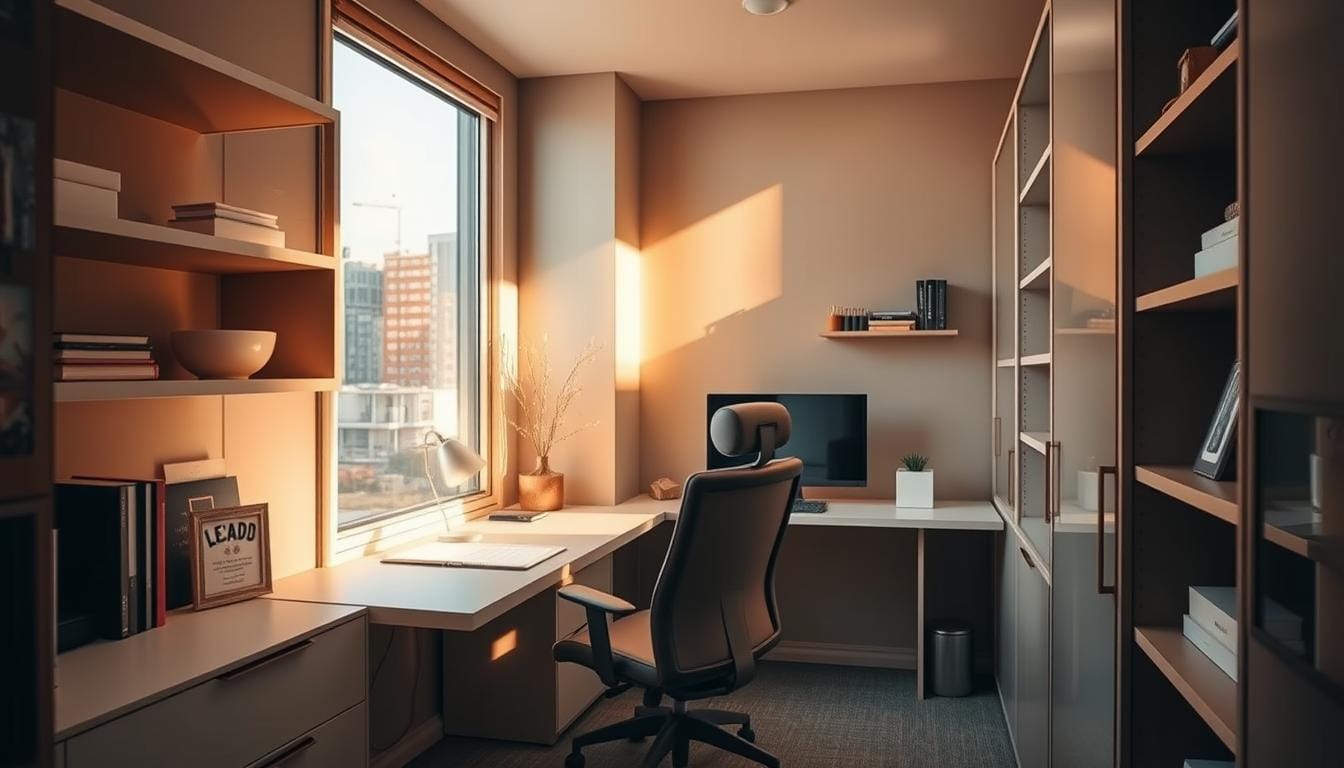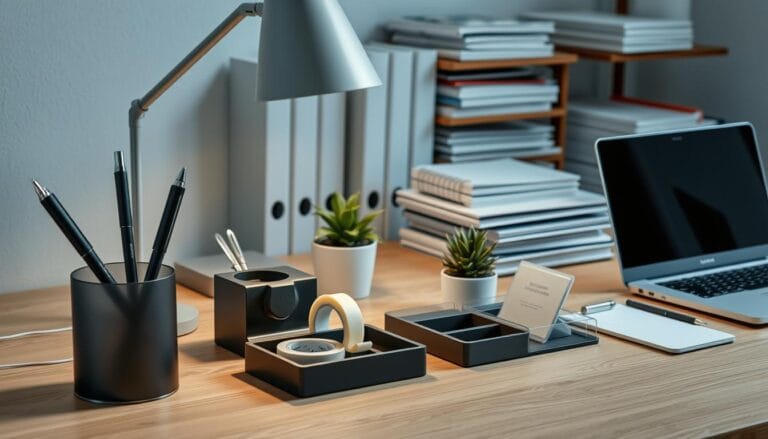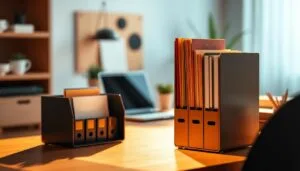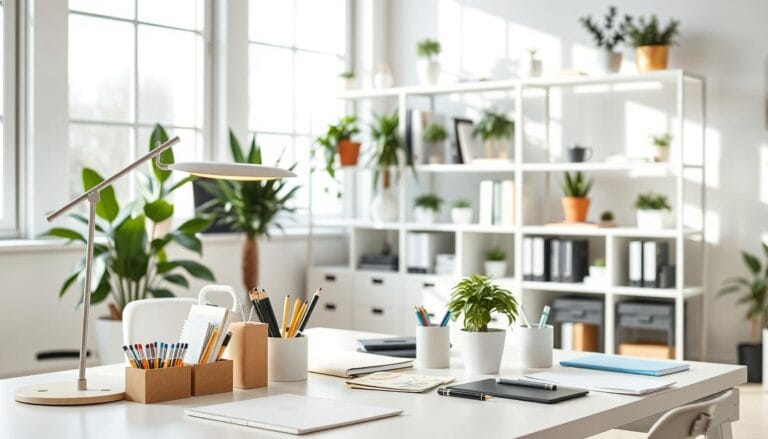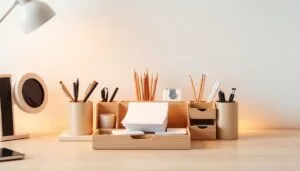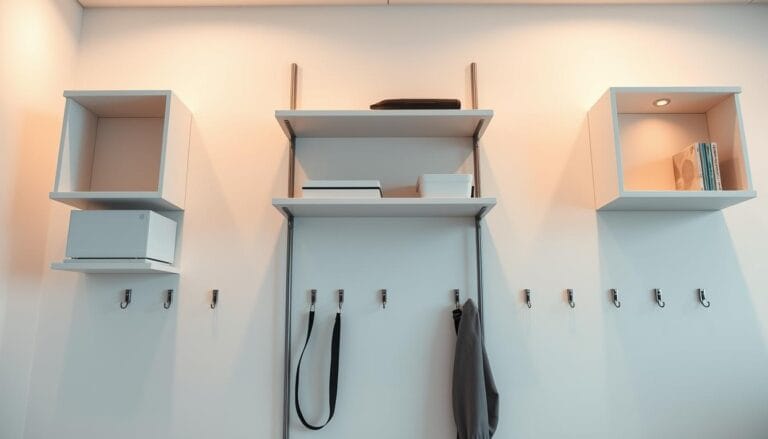How to Create a Brilliant Closet Office That Maximizes Space
Table of Contents
Space is more valuable than ever in our small homes. Remote work has changed how we work, and closets are now great for offices. You can turn unused closet space into a neat, efficient workspace that looks good with your home.
Creating a closet office is a smart move for those with little room. It works in small apartments or busy houses. This guide will show you how to make a closet office that’s both stylish and useful.
Turning your closet into a home office opens up new possibilities. You’ll learn about choosing the right desk and smart storage. You’ll see how to make a professional space that fits well in your home. Get ready to change your work area and increase your productivity in amazing ways.
Understanding the Benefits of a Closet Office Space
Turning a closet into an office can change your home workspace and how productive you are. A small office in a closet has special benefits for those working from home. It lets you use unused space for a work area that’s both useful and space-efficient.
Cost-Effective Home Office Solution
Changing a closet into an office saves money on big room additions or renting an office. You can make a small office with little money, using what’s already there. Closet conversions are cheaper than regular office makeovers, which is good for those watching their budget.
Maximizing Unused Storage Areas
Many homes have closets that aren’t used well. They can be turned into work areas easily. With smart design, you can have a work space and keep storage at the same time. Things like built-in shelves and fold-down desks make the most of your closet office.
Creating Work-Life Boundaries
A closet office helps keep work and personal life separate. When you’re done working, just close the closet doors. This helps you stay focused on your personal life, which is key for those working from home.
Essential Measurements and Planning Before Converting Your Closet
Starting a built-in office requires precise measurements and planning. Before you begin, grab a tape measure and check your closet’s size. Measure its width, depth, and height to know what you have.
The size of your closet will decide what desk, storage, and equipment you can use. Closets are usually 24 to 36 inches deep, perfect for a small desk. Don’t forget to check the ceiling height for shelving or vertical storage.
Think about the closet’s electrical outlets when planning. You’ll need power for your computer and other devices. Check if outlets are close and if you might need to upgrade the electrical system. Also, consider how much natural light the space gets to see if you need more lights.
Write down your measurements and draw a rough layout. This will help you see the closet’s potential and avoid mistakes. Good planning is key to a great and comfy workspace.
Preparing Your Closet for the Transformation
Turning a closet into a hidden office needs careful planning. Start by organizing your space to make it functional. This will help you use every inch of the closet.
First, clear out the closet. Remove hanging rods, shelves, and any hardware. Use a drill or screwdriver to take them down without damaging the walls.
Electrical Groundwork
Planning your closet’s electrical setup is key. Check if you need more outlets. You might want to hire an electrician for safe installations. Think about lighting for your tasks and computer needs.
Wall Preparation Techniques
Smooth walls are essential for a professional look. Fix any holes, sand rough spots, and prime the walls. Choose light colors like white or gray to make the space feel bigger.
Painting Your Workspace
Pick paint that fits your style. Go for semi-gloss or satin finishes for easy cleaning and light reflection. Use painter’s tape for clean lines and to protect other areas.
Selecting the Perfect Desk for Your Closet Office
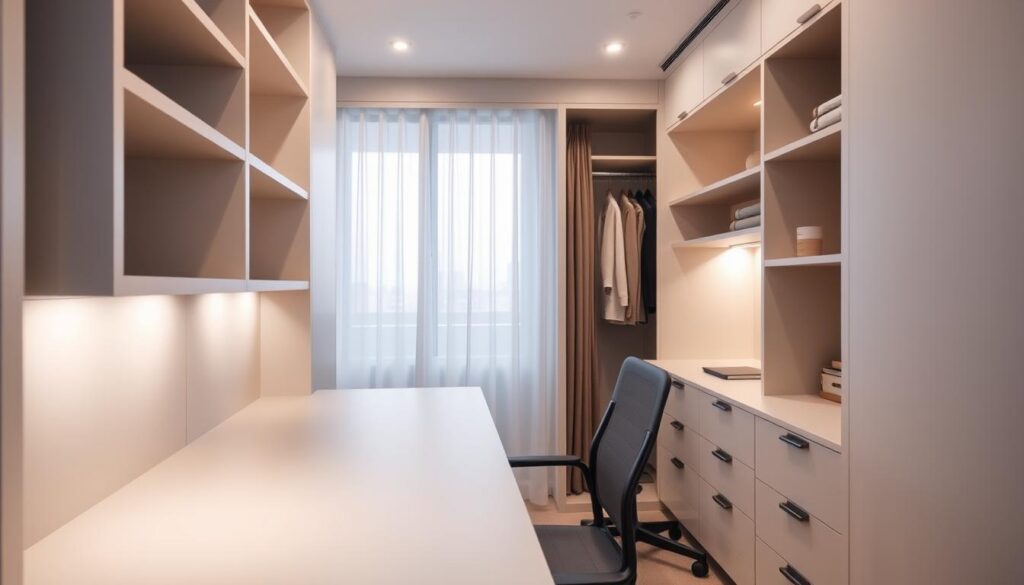
Choosing the right desk is key when turning a closet into a small office. Your desk should be small but still useful, using every inch of space. Wall-mounted or floating desks are great for small spaces, creating a workspace without taking up too much room.
Measure your closet before picking a desk. Closet desks usually are 24 to 36 inches wide. Look into fold-down or murphy-style desks that can fold up when not in use. Materials like lightweight wood, metal, or composite are best for small spaces.
Ergonomics are important, even in small spaces. Find desks with built-in keyboard trays or adjustable heights for comfort. Some desks have fold-out sections or pull-out writing surfaces for more space when needed. Choose a desk that’s functional and looks good in your small office.
Think up when planning your desk. Shelves above or beside the desk can add storage without taking up floor space. Go for slim desks with built-in cable management to keep things tidy.
The ideal closet desk should match your home’s style and offer a productive workspace. With the right choice, your small office can be both efficient and comfortable.
Smart Storage Solutions for a Functional Closet Office
Turning a small closet into a workspace needs smart ideas. You’ll want storage that uses every inch of space. The right setup can make a tiny area work well.
Vertical storage is essential in small spaces. Wall-mounted shelves keep your essentials close without cluttering your desk. Think about floating shelves or pegboard systems for custom storage.
Hidden Storage Options
Hidden storage boosts your office’s organization. Look for desks with built-in drawers or over-the-door organizers. Magnetic strips and small bins keep small items tidy without taking up space.
Cable Management Techniques
Organizing cables is key in small offices. Use cable clips, cord organizers, and boxes to avoid tangles. Velcro straps or sleeves can bundle cords, making your space look neat and organized.
Innovative Storage Accessories
Choose multi-functional storage items. Desk risers, collapsible file holders, and compact organizers save space. Good organization means finding a system that fits your needs and work style.
Lighting Options to Brighten Your Workspace
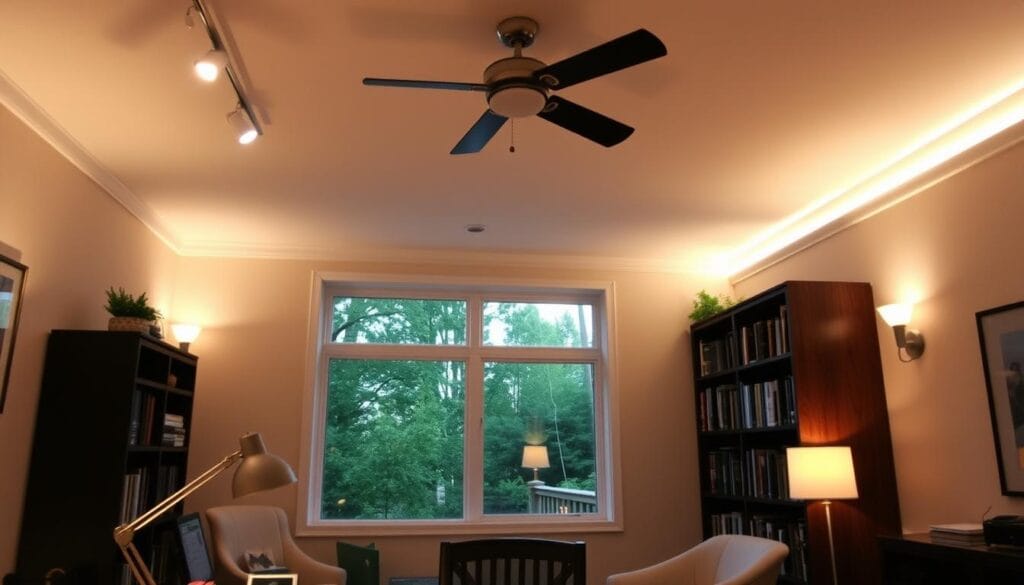
Getting the right lighting for your home office or built-in office is key. It makes your workspace both productive and comfortable. The right lighting can turn a small closet into a bright and inviting place.
Task lighting is a must in a small home office. LED desk lamps with adjustable arms are great. They shine exactly where you need them. Clip-on lights are also perfect for small spaces, adding light without taking up desk space.
Natural light is important too. If your office has a window, place your desk to catch the sun. Use sheer curtains to soften the light and keep your space bright.
Don’t forget about overhead lighting. Recessed LED lights or slim fixtures add light without taking up space. Choose bulbs that mimic natural daylight to stay alert and focused.
Smart lighting, like dimmable LED strips, is also a good choice. They can be placed under shelves or along desk edges. This adds a modern touch and practical light to your office.
Ergonomic Considerations for Your Built-in Office
Creating a cozy office closet is more than just design. Ergonomics are key to keeping you healthy and productive, even in a small space. With the right setup, your tiny office can be both comfy and efficient.
Choosing the Right Chair
Your chair is the base of comfort in your closet office. Look for a small chair that adjusts height and has lumbar support. Make sure it fits well in your closet by measuring it first. Chairs with wheels are great for tight spots, making it easy to move around.
Proper Monitor Height and Placement
Getting your monitor right prevents neck pain in small offices. Try to place it at eye level, about arm’s length away. Use wall mounts or adjustable arms to save space and get the best view. Choose a small monitor that doesn’t sacrifice quality, fitting your space perfectly.
Keyboard and Mouse Positioning
Right placement of your keyboard and mouse keeps you injury-free. Use a pull-out tray or a desk with wrist support. Keep your elbows at 90 degrees when typing. Opt for wireless or small peripherals to cut down on clutter and make the most of your space.
Space-Saving Office Equipment and Accessories
Creating a space-saving office means choosing smart equipment. Your small office needs devices that are both compact and multi-functional. These should make the most of your limited space.
Begin with a compact all-in-one printer. It should handle scanning and printing. Choose wireless models to avoid extra cables and save space. Look for printers that stand vertically or can be mounted under shelves to clear more room.
For your small office, pick multi-purpose accessories. Monitor stands with built-in storage help keep your screen up and add space. Use foldable keyboard trays and collapsible laptop stands to fit into tight spots.
Consider digital tools to cut down on physical equipment. Cloud storage replaces bulky file cabinets. Portable external hard drives offer lots of storage in small sizes. Use wireless charging stations and compact power strips to manage your devices well.
When picking office equipment, focus on items that do more than one thing. Opt for slim, sleek designs with built-in storage. This will make your small office both productive and spacious.
Design Tips for a Professional-Looking Closet Office
Turning a hidden office into a stylish workspace is all about the design. Your closet office can be a sleek and impressive spot, even if it’s small. It’s all about mixing function with style.
Selecting the Right Color Palette
Go for neutral colors to make your office feel bigger and welcoming. Soft grays, warm whites, and light blues are great for a professional vibe. They also make your space look bigger by reflecting light.
Sophisticated Decorative Elements
Add simple yet striking decor that shows off your style. Think about a sleek desk organizer, a small plant, or art that fits your professional look. These touches add flair without making your space feel cramped.
Creating a Professional Video Call Background
Your video call background is key in today’s remote world. Place your camera against a clean wall. Use a neutral backdrop or a simple art piece to look polished during calls.
With these design tips, you can turn your closet into a stylish and useful home office. It will look professional and feel roomy.
Maintaining Organization in Your Small Office Space
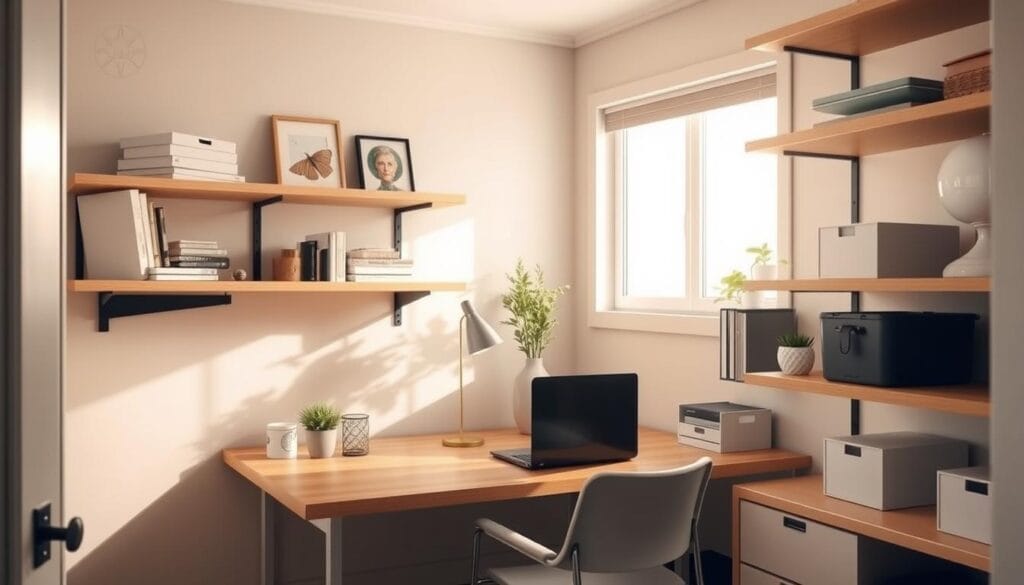
Keeping your closet desk organized is all about planning and habits. Your small space needs smart ways to stay tidy and useful. Start by focusing on what’s really important and getting rid of what you don’t need.
Using digital tools can cut down on paper clutter in your closet office. Try cloud storage and scanning apps to reduce paper. Make digital folders that match your physical setup for easy access to documents.
Set a daily routine to keep your closet office in order. Spend just five minutes each day putting things back where they belong. Use wall shelves or magnetic boards to save space. Choose compact, multi-use organizers that can be tucked away when not needed.
Decluttering regularly is key to a tidy closet desk. Plan to review your space every month to get rid of old stuff and rethink your storage. Use clear containers and labels to keep everything organized.
Good office organization is about finding a system that fits you, not being perfect. With the right management and storage, your closet desk can be a productive and organized space.
How to Create a Closet Office That’s Easy to Convert Back
When setting up your closet office, think about making it easy to change back. Use removable hardware and furniture that can be taken out. Choose light shelving from IKEA or Container Store that won’t harm walls.
Make your closet office reversible. Pick desks that don’t stick to walls, and wall organizers you can remove. Use paint that matches the room, so you can easily switch it back.
Use items like tension rods and freestanding furniture for easy moving. Wireless tech and simple cable systems mean no permanent damage. This way, your closet office stays useful and flexible.
A smartly designed closet office is very valuable. It gives you a great workspace that fits well in your home. And you can always switch it back to storage if needed. Your living space stays adaptable and useful.
Tell Us What You Think: Your Input Matters
There are no reviews yet. Be the first one to write one.

